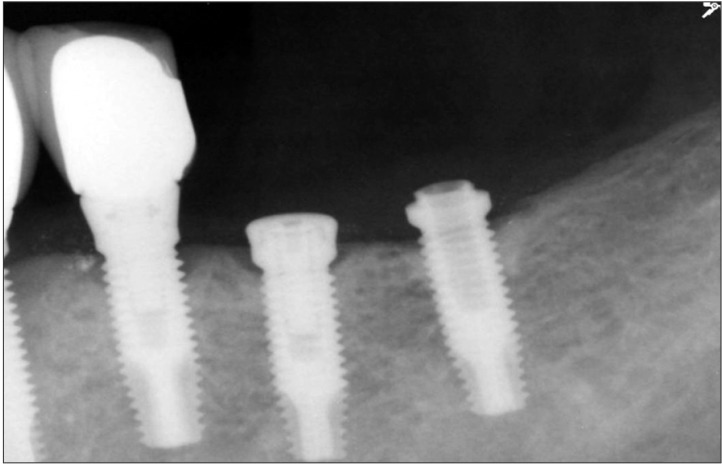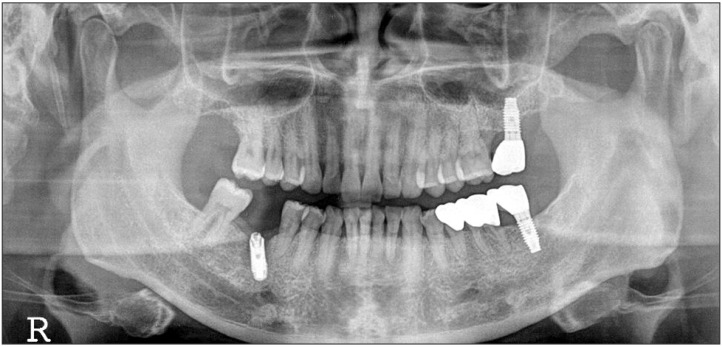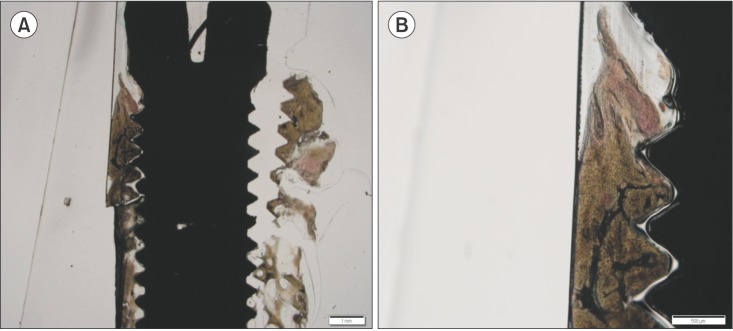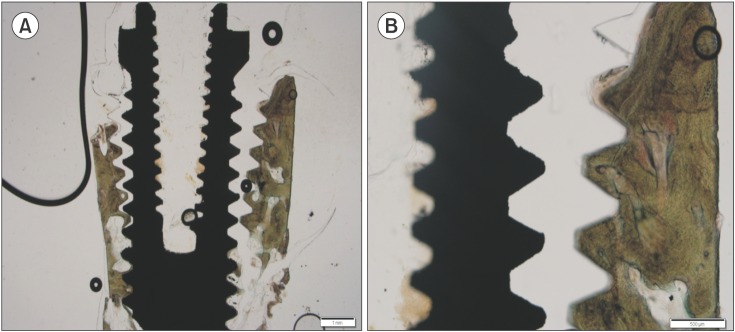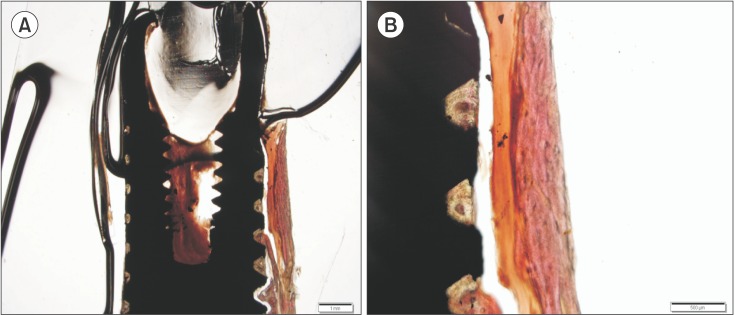J Korean Assoc Oral Maxillofac Surg.
2016 Feb;42(1):38-42. 10.5125/jkaoms.2016.42.1.38.
Histologic analysis of resorbable blasting media surface implants retrieved from humans: a report of two cases
- Affiliations
-
- 1Department of Oral and Maxillofacial Surgery, Section of Dentistry, Konyang University Hospital, Daejeon, Korea.
- 2Department of Oral and Maxillofacial Surgery, Section of Dentistry, Seoul National University Bundang Hospital, Seongnam, Korea.
- 3Department of Oral and Maxillofacial Surgery, School of Dentistry, Chosun University, Gwangju, Korea. sgckim@chosun.ac.kr
- 4Department of Pathology, School of Medicine, Chosun University, Gwangju, Korea.
- KMID: 2189410
- DOI: http://doi.org/10.5125/jkaoms.2016.42.1.38
Abstract
- The purpose of this study is to evaluate the degree of osseointegration of resorbable blasting media (RBM) surface implants retrieved from humans. Three implants in the mandibular molar region that were surface-treated with RBM were retrieved from two patients. The implants were used to manufacture specimens in order to measure the bone-implant contact (BIC) ratio. The BIC ratios of the three implants were found to be an average of 69.0%+/-9.1%. In conclusion, that RBM surface implants are integrated into the host environment with histological significance and the BIC ratio of the RBM surface-treated implant was not significantly different from that of other surface-treated implants.
Keyword
Figure
Reference
-
1. Albrektsson T. Direct bone anchorage of dental implants. J Prosthet Dent. 1983; 50:255–261. PMID: 6352912.
Article2. Eriksson C, Lausmaa J, Nygren H. Interactions between human whole blood and modified TiO2-surfaces: influence of surface topography and oxide thickness on leukocyte adhesion and activation. Biomaterials. 2001; 22:1987–1996. PMID: 11426876.
Article3. Tortamano Neto P, Camargo LO. Prospective clinical evaluation of dental implants with sand-blasted, large-grit, acid-etched surfaces loaded 6 weeks after surgery. Quintessence Int. 2004; 35:717–722. PMID: 15470995.4. Romanos GE, Testori T, Degidi M, Piattelli A. Histologic and histomorphometric findings from retrieved, immediately occlusally loaded implants in humans. J Periodontol. 2005; 76:1823–1832. PMID: 16274300.
Article5. Scarano A, Degidi M, Iezzi G, Petrone G, Piattelli A. Correlation between implant stability quotient and bone-implant contact: a retrospective histological and histomorphometrical study of seven titanium implants retrieved from humans. Clin Implant Dent Relat Res. 2006; 8:218–222. PMID: 17100747.
Article6. Degidi M, Piattelli A, Shibli JA, Perrotti V, Iezzi G. Bone formation around immediately loaded and submerged dental implants with a modified sandblasted and acid-etched surface after 4 and 8 weeks: a human histologic and histomorphometric analysis. Int J Oral Maxillofac Implants. 2009; 24:896–901. PMID: 19865630.7. Rahbek O, Kold S, Bendix K, Overgaard S, Søballe K. Superior sealing effect of hydroxyapatite in porous-coated implants: experimental studies on the migration of polyethylene particles around stable and unstable implants in dogs. Acta Orthop. 2005; 76:375–385. PMID: 16156466.8. Cook SD, Kay JF, Thomas KA, Jarcho M. Interface mechanics and histology of titanium and hydroxylapatite-coated titanium for dental implant applications. Int J Oral Maxillofac Implants. 1987; 2:15–22. PMID: 3032787.9. Brunel G, Armand S, Miller N, Rue J. Histologic analysis of a fractured implant: a case report. Int J Periodontics Restorative Dent. 2000; 20:520–526. PMID: 11203589.10. de Lange G, Tadjoedin E. Fate of the HA coating of loaded implants in the augmented sinus floor: a human case study of retrieved implants. Int J Periodontics Restorative Dent. 2002; 22:287–296. PMID: 12186351.11. Sul YT. The significance of the surface properties of oxidized titanium to the bone response: special emphasis on potential biochemical bonding of oxidized titanium implant. Biomaterials. 2003; 24:3893–3907. PMID: 12834584.
Article12. Ivanoff CJ, Widmark G, Johansson C, Wennerberg A. Histologic evaluation of bone response to oxidized and turned titanium micro-implants in human jawbone. Int J Oral Maxillofac Implants. 2003; 18:341–348. PMID: 12814308.13. Rocci A, Martignoni M, Burgos PM, Gottlow J, Sennerby L. Histology of retrieved immediately and early loaded oxidized implants: light microscopic observations after 5 to 9 months of loading in the posterior mandible. Clin Implant Dent Relat Res. 2003; 5(Suppl 1):88–98. PMID: 12691655.
Article14. Davies JE. Mechanisms of endosseous integration. Int J Prosthodont. 1998; 11:391–401. PMID: 9922731.15. Bugea C, Luongo R, Di Iorio D, Cocchetto R, Celletti R. Bone contact around osseointegrated implants: histologic analysis of a dual-acid-etched surface implant in a diabetic patient. Int J Periodontics Restorative Dent. 2008; 28:145–151. PMID: 18546810.16. Iezzi G, Scarano A, Mangano C, Cirotti B, Piattelli A. Histologic results from a human implant retrieved due to fracture 5 years after insertion in a sinus augmented with anorganic bovine bone. J Periodontol. 2008; 79:192–198. PMID: 18166111.
Article17. Testori T, Szmukler-Moncler S, Francetti L, Del Fabbro M, Scarano A, Piattelli A, et al. Immediate loading of Osseotite implants: a case report and histologic analysis after 4 months of occlusal loading. Int J Periodontics Restorative Dent. 2001; 21:451–459. PMID: 11693238.
- Full Text Links
- Actions
-
Cited
- CITED
-
- Close
- Share
- Similar articles
-
- Comparative Study of the Early Loading of Resorbable Blasting Media and Sandblasting with Large-grit and Acid-etching Surface Implants: A Retrospective Cohort Study
- Short-Term Retrospective Clinical Study of Resorbable Blasting Media Surface Tapered Implants
- The effect of conditioning by Tetracycline-HCl on implant surface: The SEM study and surface roughness measurements: RBM surface
- On the effect of saline immersion to the removal torque for resorbable blasting media and acid treated implants
- Influence of surface treatment on the insertion pattern of self-drilling orthodontic mini-implants

